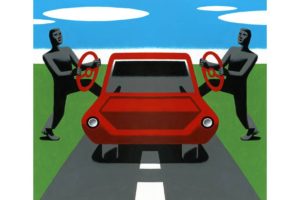WSJ Historically Speaking: A Brief History of Driving on the Left
Over the centuries, plenty of empires and nations have driven on the left side of the road

ILLUSTRATION: THOMAS FUCHS
Fifty years ago this month, on Sept. 3, 1967, the world turned upside down in Sweden. Or rather it went from left to right: On that day, the Swedes abandoned 200 years of left-hand traffic, or LHT, to switch over to RHT. The event was commemorated as Högertrafikomläggningen (the right-hand traffic diversion) or H-Day for short.
Bahrain, Finland and Iceland soon followed Sweden’s example. Pakistan considered switching to RHT in the 1960s but decided it would be too difficult, am
ong other things, to change the habits of the country’s numerous camel-cart drivers. Even the U.K. briefly toyed with the idea only to drop it because of cost and rising nationalist affection for driving on the left.
By the early 1970s, more than 160 countries had switched to RHT, leaving just the U.K., its former colonies and a few other holdouts on the left. Such is the global dominance of RHT that it might seem that humans have always felt more comfortable on the right side of life. After all, studies suggest that some 85% of people are right-handed.
But there’s nothing natural about driving on the right. Evidence from cart tracks on Roman roads in Britain suggests that traffic flowed on the left. This makes sense, since wagon drivers held their whips in their right hands, like charioteers, which causes the whip to cross diagonally to the left, make oncoming drivers less likely to get struck.
LHT continued long after the Roman Empire disappeared. Medieval knights carried their swords on the right and their shields on the left, so by keeping to the left side of the road, their sword arm was free to strike at any foe they might encounter as they traveled.
In 1300, Pope Boniface VIII instituted the first holy Jubilee, a year-long celebration of Catholic faith that prompted mass pilgrimages to Rome. The ensuing chaos on the roads forced Boniface to issue a decree ordering pilgrims to pick a side and stay left.
Five centuries later, the British government had to issue a similar directive, the General Highways Act of 1773, after the rise of mass horse-ownership led to increasing anarchy on the streets. A popular ditty ran: “As you’re driving your carriage along; / If you go to the left, you are sure to go right / If you go to the right, you are wrong.”
Driving on the left didn’t face a real challenge until Napoleon decided that all countries in the French Empire must go right—emulating France, which had switched during the Revolution. (It was considered aristocratic to hog the left side of the road.) Thus the Napoleonic War was a battle of lefts and rights, with Napoleon’s foes—Britain, Portugal, the Austro-Hungarian Empire—staying left.
The U.S. started to drift toward driving on the right after winning its independence, probably to make an anti-British point. Yet the person most responsible for RHT in America was Henry Ford. Before then, the wheel and controls were sometimes on the right or even in the middle of the car. In 1908, Ford announced a new model that had the steering wheel on the left, so that passengers would always exit curbside—“especially,” the publicity materials claimed, “if there is a lady to be considered.”
Driving on the right received a grim boost from Hitler, whose megalomania, like Napoleon’s, was such that all conquered countries had to emulate German RHT.
When not being propelled by imperialism or capitalism, does RHT always win over LHT? Apparently not. In 1978, Japan went fully LHT, as did Samoa in 2009. As with so much in life, humans are unpredictable, stubborn creatures who, given the chance, will go in any direction they please.
